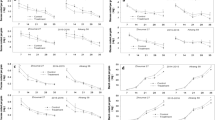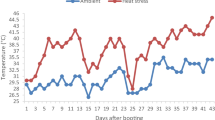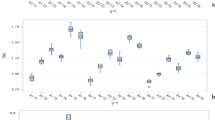Abstract
Background and Aims
Magnesium (Mg) has diverse functions in plants and plays a critical role in carbohydrate partitioning between source and sink tissues. There is, however, limited information available about the effects of Mg deficiency on grain starch accumulation, yield formation and seed quality in terms of seed germination and seedling establishment in wheat.
Methods
In a solution culture experiment, bread wheat (Triticum aestivum) was grown to maturity with low or adequate Mg under greenhouse conditions, and a post-anthesis foliar Mg application was tested on low-Mg plants. The effects of these Mg treatments on i) yield parameters, ii) distribution of starch among sink and source organs, iii) tissue concentrations of Mg and other minerals and iv) seed germination and seedling development were investigated.
Results
Low Mg supply did not affect the vegetative biomass production; but substantially reduced the grain yield. Post-anthesis foliar Mg spray significantly minimized yield losses caused by Mg deficiency. Decreases in grain yield by Mg deficiency were due to decreases in individual seed weight rather than seed number per spike. Low Mg depressed the grain and root starch levels, while increasing the leaf starch. Foliar Mg spray largely reversed these effects of Mg deficiency. Seeds obtained from low-Mg plants exhibited severe impairments in germination and seedling establishment. These seed quality traits were also greatly improved by foliar Mg application to maternal plants.
Conclusions
Magnesium deficiency reduces grain yield in wheat mainly by limiting the carbohydrate supply to developing seeds and thus by decreasing the seed weight. Since vegetative growth is far less affected than yield formation, Mg deficiency may remain latent until seed-filling. Therefore, foliar Mg application appears to be a promising tool to alleviate Mg deficiency during seed-filling and minimize its impact on yield and seed quality.



Similar content being viewed by others
References
Al’shevskii NG, Derebon YG (1982) Effect of magnesium fertilizers on yield and quality of winter wheat. Khimiya v Sel’skom Khozyaistve 4:17–20
Aoki N, Scofield GN, Wang XD, Offler CE, Patrick JW, Furbank RT (2006) Pathway of sugar transport in germinating wheat seeds. Plant Physiol 141:1255–1263. doi:10.1104/pp.106.082719
Araus JL, Slafer GA, Royo C, Serret MD (2008) Breeding for yield potential and stress adaptation in cereals. Crit Rev Plant Sci 27:377–412. doi:10.1080/07352680802467736
Barlog P, Grzebisz W (2001) Effect of magnesium foliar application on the yield and quality of sugar beet roots. Rost Vyroba 47:418–422
Beringer H, Forster H (1981) Einfluss variierter Mg-Ernaehrung auf Tausendkorngewicht und P-Fraktionen des Gerstenkorns. J Plant Nutr Soil Sci 144:8–15. doi:10.1002/jpln.19811440104
Bose J, Babourina O, Rengel Z (2011) Role of magnesium in alleviation of aluminium toxicity in plants. J Exp Bot 62:2251–2264. doi:10.1093/jxb/erq456
Boyer PD (1997) The ATP synthase - a splendid molecular machine. Annu Rev Biochem 66:717–749. doi:10.1146/annurev.biochem.66.1.717
Brown PH, Welch RM, Cary EE (1987) Nickel: a micronutrient essential for higher plants. Plant Physiol 85:801–880. doi:10.1104/pp.85.3.801
Bush DR (1989) Proton-coupled sucrose transport in plasmalemma vesicles isolated from sugar beet (Beta vulgaris L cv Great Western) leaves. Plant Physiol 89:1318–1323. doi:10.1104/pp.89.4.1318
Cai J, Chen L, Qu H, Lian J, Liu W, Hu Y, Xu G (2012) Alteration of nutrient allocation and transporter genes expression in rice under N P K and Mg deficiencies. Acta Physiol Plant 34:939–946. doi:10.1007/s11738-011-0890-x
Cakmak I (2008) Enrichment of cereal grains with zinc: agronomic or genetic biofortification? Plant Soil 302:1–17. doi:10.1007/s11104-007-9466-3
Cakmak I (2013) Magnesium in crop production food quality and human health. Plant Soil 368:1–4. doi:10.1007/s11104-013-1781-2
Cakmak I (2015) Magnesium in crop production food quality and human health. Crop Pasture Sci 66:i–ii. doi:10.1071/CPv66n12_FO
Cakmak I, Kirkby EA (2008) Role of magnesium in carbon partitioning and alleviating photooxidative damage. Physiol Plant 133:692–704. doi:10.1111/j.1399-3054.2007.01042.x
Cakmak I, Yazici A (2010) Magnesium: A forgotten element in crop production. Better Crops 94:23–25
Cakmak I, Hengeler C, Marschner H (1994a) Partitioning of shoot and root dry matter and carbohydrates in bean plants suffering from phosphorus potassium and magnesium deficiency. J Exp Bot 45:1245–1250. doi:10.1093/jxb/45.9.1245
Cakmak I, Hengeler C, Marschner H (1994b) Changes in phloem export of sucrose in leaves in response to phosphorus potassium and magnesium deficiency in bean plants. J Exp Bot 45:1251–1257. doi:10.1093/jxb/45.9.1251
Craighead MD, Martin RJ (2001) Responses to magnesium fertilizers in wheat in Mid Canterbury. P Ag Soc Nz 31:63–70
de Baaij JHF, Hoenderop JGJ, Bindels RJM (2015) Magnesium in man: implications for health and disease. Physiol Rev 95:1–46. doi:10.1152/physrev.00012.2014
Ding Y, Xu G (2011) Low magnesium with high potassium supply changes sugar partitioning and root growth pattern prior to visible magnesium deficiency in leaves of Rice (Oryza sativa L). Am J Plant Sci 2:601–608. doi:10.4236/ajps.2011.24071
Ding Y, Luo W, Xu G (2006) Characterisation of magnesium nutrition and interaction of magnesium and potassium in rice. Ann Appl Biol 149:111–123. doi:10.1111/j.1744-7348.2006.00080.x
Distelfeld A, Cakmak I, Peleg Z, Ozturk L, Yazici AM, Budak H, Saranga Y, Fahima T (2007) Multiple QTL-effects of wheat Gpc-B1 locus on grain protein and micronutrient concentrations. Physiol Plant 129:635–643. doi:10.1111/j.1399-3054.2006.00841.x
Douglass SK, Juvik JA, Splittstoesser WE (1993) Sweet corn seedling emergence and variation in kernel carbohydrate reserves. Seed Sci Technol 21:433–445
Elias EM, Manthey FA (2005) Durum wheat breeding at North Dakota State University. In: Royo C, Nachit ,MM, DiFonzo N, Araus JL, Pfeiffer WH, Slafer GA (eds) Durum wheat breeding: current approaches and future strategies. Food Products Press, New York, pp. 939–962
Epstein E, Bloom AJ (2005) Mineral nutrition of plants: Principles and perspectives, 2nd edn. Sinauer Associates, Sunderland
Fageria NK, Filho MB, Moreira A, Guimaraes CM (2009) Foliar fertilization of crop plants. J Plant Nutr 32:1044–1064. doi:10.1080/01904160902872826
Gebbing T, Schnyder H, Kühbauch W (1999) The utilization of pre anthesis reserves in grain filling of wheat. assessment by steady state 13CO2/12CO2 labeling. Plant Cell Environ 22:851–858. doi:10.1046/j.1365-3040.1999.00436.x
Gerendás J, Führs H (2013) The significance of magnesium for crop quality. Plant Soil 368:101–128. doi:10.1007/s11104-012-1555-2
Gooding MJ, Davies WP (1992) Foliar urea fertilization of cereals: A review. Fert Res 32:209–222. doi:10.1007/BF01048783
Gransee A, Fuhrs H (2013) Magnesium mobility in soils as a challenge for soil and plant analysis magnesium fertilization and root uptake under adverse growth conditions. Plant Soil 368:5–21. doi:10.1007/s11104-012-1567-y
Greffeuille V, Abecassis J, Lapierre C, Lullien-Pellerin V (2006) Bran size distribution at milling and mechanical and biochemical characterization of common wheat grain outer layers: a relationship assessment. Cereal Chem 83:641–646. doi:10.1094/CC-83-0641
Grewal HS, Graham RD (1997) Seed zinc content influences early vegetative growth and zinc uptake in oilseed rape (Brassica napus and Brassica juncea) genotypes on zinc-deficient soil. Plant Soil 192:191–197. doi:10.1023/A:1004216111647
Grzebisz W (2013) Crop response to magnesium fertilization as affected by nitrogen supply. Plant Soil 368:23–39. doi:10.1007/s11104-012-1574-z
Hermans C, Verbruggen N (2005) Physiological characterization of Mg deficiency in Arabidopsis thaliana. J Exp Bot 56:2153–2161. doi:10.1093/jxb/eri215
Hermans C, Johnson GN, Strasser RJ, Verbruggen N (2004) Physiological characterization of magnesium deficiency in sugar beet: acclimation to low magnesium differentially affects photosystems I and II. Planta 220:344–355. doi:10.1007/s00425-004-1340-4
Hermans C, Bourgis F, Faucher M, Strasser RJ, Delrot S, Verbruggen N (2005) Magnesium deficiency in sugar beets alters sugar partitioning and phloem loading in young mature leaves. Planta 220:541–549. doi:10.1007/s00425-004-1376-5
Hucl P (1996) Out-crossing rates for 10 Canadian spring wheat cultivars. Can J Plant Sci 76:423–427. doi:10.4141/cjps96-075
Igamberdiev AU, Kleczkowski LA (2015) Optimization of ATP synthase function in mitochondria and chloroplasts via the adenylate kinase equilibrium. Front Plant Sci 6:10. doi:10.3389/fpls.2015.00010
Jezek M, Geilfus CM, Bayer A, Mühling KH (2015) Photosynthetic capacity nutrient status and growth of maize (Zea mays L) upon MgSO4 leaf-application. Front Plant Sci 5:781. doi:10.3389/fpls.2014.00781
Jones JB Jr, Wolf B, Mills HA (1991) Plant analysis handbook: A practical sampling, preparation, analysis, and interpretation guide. Micro–Macro Publishing, Athens Georgia
Kutman UB, Kutman BY, Ceylan Y, Ova EA, Cakmak I (2012) Contributions of root uptake and remobilization to grain zinc accumulation in wheat depending on post-anthesis zinc availability and nitrogen nutrition. Plant Soil 361:177–187. doi:10.1007/s11104-012-1300-x
Kutman BY, Kutman UB, Cakmak I (2013) Foliar nickel application alleviates detrimental effects of glyphosate drift on yield and seed quality of wheat. J Agric Food Chem 61:8364–8372. doi:10.1021/jf402194v
Laing W, Greer D, Sun O, Beets P, Lowe A, Payn T (2000) Physiological impacts of Mg deficiency in Pinusradiata: growth and photosynthesis. New Phytol 146:47–57. doi:10.1046/j.1469-8137.2000.00616.x
Lambers H, Chapin III FS, Pons TL (2008) Mineral nutrition. In: Plant physiological ecology, 2nd edn. Springer, New York, pp 255–320
Lineback DR, Rasper VF (1988) Wheat carbohydrates. In: Pomeranz Y (ed) Wheat: chemistry and technology, vol 1. American Association of Cereal Chemists, MN, pp. 277–372
Longnecker N, Crosbie J, Davies F, Robson A (1996) Low seed manganese concentration and decreased emergence of Lupinus angustifolius. Crop Sci 36:355–361. doi:10.2135/cropsci1996.0011183X003600020024x
Marschner P (2012) Marschner’s mineral nutrition of higher plants, 3rd edn. Elsevier, Academic Press, USA
McDonald AJ, Ericsson T, Larsson CM (1996) Plant nutrition, dry matter gain and partitioning at the whole-plant level. J Exp Bot 47:1245–1253
Mengel K, Kirkby EA (2001) Principles of plant nutrition, 5th edn. Springer, Dordrecht
Mengutay M, Ceylan Y, Kutman UB, Cakmak I (2013) Adequate magnesium nutrition mitigates adverse effects of heat stress on maize and wheat. Plant Soil 368:57–72. doi:10.1007/s11104-013-1761-6
Neuhaus C, Geilfus CM, Mühling KH (2014) Increasing root and leaf growth and yield in Mg-deficient faba beans (Viciafaba) by MgSO4 foliar fertilization. J Plant Nutr Soil Sc 177:741–747. doi:10.1002/jpln.201300127
Perl M (1986) ATP synthesis and utilization in the early stage of seed germination in relation to seed dormancy and quality. Physiol Plant 66:177–182. doi:10.1111/j.1399-3054.1986.tb01253.x
Portis AR Jr (1992) Regulation of ribulose 15-bisphosphate carboxylase/oxygenase activity. Annu Rev Plant Physiol 43:415–437. doi:10.1146/annurev.pp.43.060192.002215
Rerkasem B, Bell RW, Lodkaew S, Loneragan JF (1997) Relationship of seed boron concentration to germination and growth of soybean (Glycine max). Nutr Cycl Agroecosyst 48:217–223. doi:10.1023/A:1009725311624
Reuter DJ, Robinson JB (1997) Plant analysis: an interpretation manual, 2nd edn. Csiro publishing, Collingwood Vic
Rosanoff A (2013) Changing crop magnesium concentrations: impact on human health. Plant Soil 368:139–153. doi:10.1007/s11104-012-1471-5
Royo C, Ramdani A, Moragues M, Villegas D (2006) Durum wheat under mediterranean conditions as affected by seed size. J Agron Crop Sci 192:257–266. doi:10.1111/j.1439-037X.2006.00215.x
Ruan YL, Patrick JW, Bouzayen M, Osorio S, Fernie AR (2012) Molecular regulation of seed and fruit set. Trends Plant Sci 17:656–665. doi:10.1016/j.tplants.2012.06.005
Schnyder H (1993) The role of carbohydrate storage and redistribution in the source-sink relations of wheat and barley during grain filling – a review. New Phytol 123:233–245. doi:10.1111/j.1469-8137.1993.tb03731.x
Scofield GN, Aoki N, Hirose T, Takano M, Jenkins CL, Furbank RT (2007) The role of the sucrose transporter, OsSUT1, in germination and early seedling growth and development of rice plants. J Exp Bot 58:483–495. doi:10.1093/jxb/erl217
Scott BJ, Robson AD (1991) The distribution of Mg P and K in the split roots of subterranean clover. Ann Bot London 67:251–256
Shaul O (2002) Magnesium transport and function in plants: the tip of the iceberg. Biometals 15:307–321. doi:10.1023/A:1016091118585
Siegenthaler PA, Douet-Orhant V (1994) Relationship between the ATP content measured at three imbibition times and germination of onion seeds during storage at 3, 15 and 30 C. J Exp Bot 45:1365–1371. doi:10.1093/jxb/45.10.1365
Sreedhara A, Cowan JA (2002) Structural and catalytic roles for divalent magnesium in nucleic acid biochemistry. Biometals 15:211–223. doi:10.1023/A:1016070614042
Sylvester-Bradley R, Lunn G, Foulkes J, Shearman V, Spink J, Ingram J (2002) Management strategies for high yields of cereals and oilseed rape. HGCA Conference: Agronomic Intelligence: the basis for profitable production
Vrataric M, Sudaric A, Kovacevic V, Duvnjak T, Krizmanic M, Mijic A (2006) Response of soy bean to foliar fertilization with magnesium sulphate (Epsom salt). Cereal Res Commun 34:709–712. doi:10.1556/CRC.34.2006.1.177
Wang T, Sistrunk LA, Leskovar DI, Cobb BG (2011) Characteristics of storage reserves of triploid watermelon seeds: association of starch and mean germination time. Seed Sci Technol 39:318–326
Wang Z, Cai J, Liu F, Jin M,. Yu H, Jiang D, Wollenweber B (2012) Pre-anthesis high temperature acclimation alleviates the negative effects of post-anthesis heat stress on stem stored carbohydrates remobilization and grain starch accumulation in wheat. J Cereal Sci 55:331–336. doi:10.1016/j.jcs.2012.01.004
Wedding RT, Black MK (1988) Role of magnesium in the binding of substrate and effectors to phosphoenolpyruvate carboxylase from a CAM plant. Plant Physiol 87:443–446. doi:10.1104/pp.87.2.443
Weitbrecht K, Müller K, Leubner-Metzger G (2011) First off the mark: early seed germination. J Exp Bot 62:3289–3309. doi:10.1093/jxb/err030
Welch RM (1999) Importance of seed mineral nutrient reserves in crop growth and development. In: Rengel Z (ed) Mineral nutrition of crops: fundamental mechanisms and implications. The Haworth Press, New York, pp. 205–226
White JP, Broadley MR (2008) Biofortification of crops with seven mineral elements often lacking in human diets: iron zinc copper calcium magnesium selenium and iodine. New Phytol 182:49–84. doi:10.1111/j.1469-8137.2008.02738.x
Williams LE, Hall JL (1987) ATPase and proton pumping activities in cotyledons and other phloem containing tissues of Ricinuscommunis. J Exp Bot 38:185–202. doi:10.1093/jxb/38.2.185
Worthington V (2001) Nutritional quality of organic versus conventional fruits vegetables and grains. J Altern Complement Med 7:161–173. doi:10.1089/107555301750164244
Yang JC, Zhang JH (2006) Grain filling of cereals under soil drying. New Phytol 169:223–236
Yazaki Y, Asukagawa N, Ishikawa Y, Ohta E, Sakata M (1988) Estimation of cytoplasmic free Mg2+ levels and phosphorylation potentials in mung bean root tips by in vivo 31P NMR spectroscopy. Plant Cell Physiol 29:919–924
Zengin M, Gokmen F, Gezgin S, Cakmak I (2008) Effects of different fertilizers with potassium and magnesium on the yield and quality of potato. Asian J Chem 20:663–676
Acknowledgments
This study has been supported by K-S Kali GmbH in Germany and TUBITAK (The Scientific and Technological Research Council of Turkey).
Author information
Authors and Affiliations
Corresponding author
Additional information
Responsible Editor: Philip John White .
Rights and permissions
About this article
Cite this article
Ceylan, Y., Kutman, U.B., Mengutay, M. et al. Magnesium applications to growth medium and foliage affect the starch distribution, increase the grain size and improve the seed germination in wheat. Plant Soil 406, 145–156 (2016). https://doi.org/10.1007/s11104-016-2871-8
Received:
Accepted:
Published:
Issue Date:
DOI: https://doi.org/10.1007/s11104-016-2871-8




